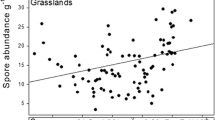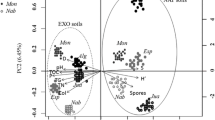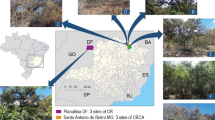Abstract
Variation in arbuscular mycorrhizal fungi (AMF) communities is described for the first time in rupestrian grasslands in Brazil along an altitudinal gradient of 700 m (800 to 1400 m a.s.l.). Hypotheses tested were that soil properties influence the variation in AMF communities and that the frequency of the most common species of AMF is inversely influenced by the richness of other AMF. Field and laboratory data were collected on AMF community composition, richness, density, and frequency in the altitudinal gradient, and the relationships with several physical–chemical soil properties and altitude were evaluated. Fifty-one species of AMF were recorded, with 14 species being reported as possibly new to science and nine species representing new records for Brazil. This single elevation gradient alone contains 22 % of the known world diversity of AMF. Soil properties and AMF community density and richness varied significantly along the elevation (p < 0.05). AMF density and richness were higher at the intermediate altitude, while AMF species composition differed statistically among the altitudes.




Similar content being viewed by others
References
Abbott LK, Robson AD (1991) Factors influencing the occurrence of vesicular-arburcular mycorrhizas. Agric Ecosyst Environ 35:121–150
Benedetti T, Antoniolli ZI, Giracca EMN, Steffen RB (2005) Diversidade de fungos micorrízicos arbusculares na cultura do milho após uso de espécies de plantas de cobertura de solo. Rev Ciênc Agrov 4:44–51
Benites VM, Caiafa AN, Mendonça ES, Schaefer CE, Ker JC (2003) Solos e vegetação nos complexos rupestres de altitude da Mantiqueira e do Espinhaço. Floram 10:76–85
Berbara RLL, De Sousa FA, Fonseca HMA (2006) Fungos micorrízicos arbusculares: muito além da nutrição. In: Fernandes MS (ed) Nutrição mineral de plantas. SBCS, Viçosa, pp 53–88
Bryant JA, Lamanna C, Morlon H, Kerkhoff AJ, Enquist BJ, Green JL (2008) Microbes on mountainsides: contrasting elevational patterns of bacterial and plant diversity. PNAS 105:11505–11511
Brower JE, Zar JH, Von Ende CN (1990) Field and laboratory methods for general ecology, 3rd edn. WM C. Brown Publishers, Dubuque, p 288
Caproni AL, Franco AA, Berbara RLL, Trufem SB, Granha JRDO, Monteiro AB (2003) Ocorrência de fungos micorrízicos arbusculares em áreas revegetadas após mineração de bauxita em Porto Trombetas, Pará. Pesq Agrop Brasileira 38:1409–1418
Carrenho R, Trufem SFB, Bononi VRL (2001) Fungos micorrízicos arbusculares em rizosferas de três espécies de fitobiontes instaladas em área de mata ciliar revegetada. Acta Bot Bras 15:115–124
Carvalho F, Souza FA, Carrenho R, Moreira FMS, Jesus EC, Fernandes GW (2012) The mosaic of habitats in the high-altitude Brazilian rupestrian fields is a hotspot for arbuscular mycorrhizal fungi. Appl Soil Ecol 52:9–19
Cavalcante UMT, Goto BT, Maia LC (2009) Aspectos da simbiose micorrízica arbuscular. An Acad Pe Cien Agr 5(6):180–208
Conceição AA, Giulietti AM (2002) Composição florística e aspectos estruturais de campo rupestre em dois platôs do Morro do Pai Inácio, Chapada Diamantina, Bahia, Brasil. Hoehnea 29:37–48
Conceição AA, Pirani JR (2007) Diversidade em quatro áreas de campos rupestres na Chapada Diamantina, Bahia, Brasil: espécies distintas, mais riquezas similares. Rodriguésia 58:193–206
Connell JH (1978) Community interactions on marine rocky intertidal shores. Annu Rev Ecol Evol Syst 3:169–192
Cowell RK (2006) Estimate S: Statistical estimator of species richness and shared species from samples. Version 8.0. Persistent
Crawley M (2002) Statistical computing: an introduction to data analysis using S-Plus. Wiley, Baffins Lane, 761 pp
Diaz HF, Grosjean M, Graumlich L (2003) Climate variability and change in high elevation regions: past, present and future. Clim Chang 59:1–4
Dossin IA, Dossin TM, Chaves MLSC (1990) Compartimentação estratigráfica do supergrupo Espinhaço em Minas Gerais—Os grupos Diamantina e Conselheiro Mata. Rev Bras Geoci 20:178–186
Embrapa - Empresa Brasileira de Pesquisa Agropecuária (1997) Manual de métodos e análises de solo, 2nd edn. Embrapa, Rio de Janeiro
Fernandes GW, Barbosa NPU, Negreiros D, Paglia AP (2014) Challenges for the conservation of vanishing megadiverse rupestrian grasslands. Nat Conserv 12:162–165
Fernandes GW, Oki Y, Sanchez-Azofeifa A, Faccion G, Amaro-Arruda HC (2011) Hail impact on leaves and endophytes of the endemic threatened Coccoloba cereifera (Polygonaceae). Plant Ecol 212:1687–1697
Fernandes GW, Price PW (1988) Biogeographical gradients in galling species richness: tests of hypotheses. Oecologia 76:161–167
Fernandes GW, Price PW (1991) Comparison of tropical and temperate galling species richness: the roles of environmental harshness and plant nutrient status, pp 91–115. In: Price PW, Lewinsohn TM, Fernandes GW, Benson WW (eds.). Plant-animal interactions: evolutionary ecology in tropical and temperate regions. Wiley & Sons, xiv + 637 pp
Fierer N, McCain CM, Meir P, Zimmermann M, Rapp JM, Silman MR, Knight R (2011) Microbes do not follow the elevational diversity patterns of plants and animals. Ecology 92:797–804
Fischer A, Blaschke M, Bässler C (2011) Altitudinal gradients in biodiversity research: the state of the art and future perspectives under climate change aspects. For Ecol Landsc Res Nat Conserv 11:35–47
Gerdemann JW, Nicolson TH (1963) Spores of mycorrhizal Endogone species extracted from soil by wet-sieving and decanting. T Br Mycol Soc 46:235–244
Giovannetti M, Gianinazzi-Pearson V (1994) Biodiversity in arbuscular mycorrhizal fungi. Mycol Res 98:705–715
Giulietti AM, Menezes NL, Pirani JR, Meguro M, Wanderley MGL (1987) Flora da Serra do Cipó, Minas Gerais: caracterização e lista de espécies. Bol Bot 9:1–151
Giulietti AM, Pirani JR (1988) Patterns of geographic distribution of some plant species from the Espinhaco range, Minas Gerais and Bahia, Brazil. In: Proceedings of a workshop on Neotropical Distribution Patterns (Vanzolini PE, Heyer WR). Rio de Janeiro: Acad Bras Cienc pp 39–69
Gomide PHO, Silva MLN, Soares CRFS, Cardoso EL, Carvalho F, Leal PL, Marques RM, Stürmer SL (2014) Fungos micorrízicos arbusculares em fitofisionomias do Pantanal da Nhecolândia, Mato Grosso do Sul. Rev Bras Ciênc Solo 38:1114–1127
Goto BT, Silva GA, Yano-Melo AM, Maia LC (2010) Checklist of the arbuscular mycorrhizal fungi (Glomeromycota) in the Brazilian semiarid. Mycotaxon 113:251–254
Hammer O, Harper DAT, Ryan PD (2001) Past: paleontological statistics software package for education and data analysis. Paleontol Electron 4:1–9
Harley RM (1995) Introduction. In: Stannard BL (ed) Flora of the Pico das Almas, Chapada Diamantina, Bahia. Bot Gard, Kew. pp 1–78
Jenkins WR (1964) A rapid centrifugal-flotation technique for separating nematodes from soil. Plant Dis Repor 48:692 pp
Johnson NC, Wedin DA (1997) Soil carbon, nutrients, and mycorrhizae during conversion of dry tropical forest to grassland. Ecol Appl 7:171–182
Kohler T, Giger M, Hurni H, Ott C, Wiesmann U, Von Dach SW, Maselli D (2010) Mountains and climate change: a global concern. Mt Res Dev 30:53–55
Kumar A, Longino JT, Colwell RK, O’Donnell S (2009) Elevational patterns of diversity and abundance of eusocial paper wasps (Vespidae) in Costa Rica. Biotropica 41:338–346
Lara ACF, Fernandes GW (1996) The highest diversity of galling insects: Serra do Cipó, Brazil. Biodivers Lett 3:111–114
Lisboa FJG, Chaer G, Fernandes MF, Berbara RLL, Madari B (2014) The match between microbial community structure and soil properties is modulated by land use types and sample origin within an integrated agroecosystem. Soil Biol Biochem 78:97–118
Lima LS, Soares ACF, Souza CS (2013) Ocorrência e atividade de fungos micorrízicos arbusculares em plantios de eucalipto (Eucalyptus sp.) no litoral norte da Bahia, Brasil. Rev Arv 37:245–255
Lomolino MV (2001) Elevation gradients in species density: historical and prospective views. Glob Ecol Biogeogr 10:3–13
Lugo MA, Ferrero M, Menoyo E, Estévez MC, Siñeriz F, Anton A (2008) Arbuscular mycorrhizal fungi and rhizospheric bacteria diversity along an altitudinal gradient in south American Puna Grassland. Microb Ecol 55:705–713
Madeira JA, Fernandes GW (1990) Reproductive phenology of sympatric Chamaecrista taxa of Chamaecrista (Leguminosae) in Serra do Cipó, Brazil. J Trop Ecol 15:463–479
Malhi Y, Silman M, Salinas N, Bush M, Meir P, Saatchi S (2010) Introduction: elevation gradients in the tropics: laboratories for ecosystem ecology and global change research. Glob Chang Biol 16:3171–3175
McCune B, Mefford MJ (1997) PC-ORD: Multivariate analysis of ecological data—version 3.0. Oregon: MJM Software Design, Gleneden Beach 43p
Mello AH, Antoniolli ZI, Kaminski J, Souza EL, Oliveira VL (2006) Fungos arbusculares e ectomicorrízicos em áreas de eucalipto e de campo nativo em solo arenoso. Cienc Flor 16:293–301
Miranda JCC (2008) Cerrado: Micorriza arbuscular: ocorrência e manejo. Embrapa Cerrados, Planaltina, 169 pp
Moreira FMS, Carvalho TS, Siqueira JO (2010) Effect of fertilizers, lime, and inoculation with rhizobia and mycorrhizal fungi on the growth of four leguminous tree species in a low-fertility soil. Biol Fertil Soils 46:771–779
Moreira M, Baretta D, Tsai SM, Gomes-da-Costa SM, Cardoso EJBN (2007) Biodiversity and distribution of arbuscular mycorrhizal fungi in Araucaria angustifolia Forest. Sci Agric 64:393–399
Morton JB, Bentivenga SP, Wheeler WW (1993) Germplasm in the internacional collection of arbuscular and vesicular-arbuscular mycohrrizal fungi (INVAM) and procedures for culture development, documentation and storage. Mycotaxon 48:491–528
Negreiros D, Fernandes GW, Berbara RLL, Rodarte LHO, Barbosa NPU (2011) Caracterização físico-química de solos quartzíticos degradados e áreas adjacentes de campo rupestre na Serra do Cipó, MG, Brasil. Neotrop Biol Cons 6:156–161
Negreiros D, Fernandes GW, Silveira FAOS, Chalub S (2009) Seedling growth and biomass allocation of endemic and threatened shrubs of rupestrian fields. Acta Oecol 35:301–310
Negreiros D, Moraes MLB, Fernandes GW (2008) Caracterização da fertilidade dos solos de quatro leguminosas de campos rupestres, Serra do Cipó, MG, Brasil. J Soil Sci Plant Nutrit 8:30–39
Nobre CP, Ferraz Júnior ASL, Goto BT, Berbara RLL, Nogueira MDC (2010) Fungos micorrízicos arbusculares em sistema de aléias no Estado do Maranhão, Brasil. Acta Amazon 40:641–646
Nunes YRF, Landau EC, Veloso MDM (2008) Diversidade de Melastomataceae em diferentes altitudes de campos rupestres na Serra do Cipó, MG. Unimontes Cient 10:34–45
Oehl F, Silva GA, Goto BT, Maia LC, Sieverding E (2011) Glomeromycota: two new classes and a new order. Mycotaxon 116:365–379
Pagano MC, Scotti MR (2009) A survey of the arbuscular mycorrhiza occurrence in Paepalanthus bromelioides and Bulbostylis sp. in rupestrian fields, Brazil. Micol Apl Int 21:1–10
Pagano MC, Zandavalli RB, Araújo FS (2013) Biodiversity of arbuscular mycorrhizas in three vegetational types from the semiarid of Ceará State, Brazil. Appl Soil Ecol 67:37–46
Ramsay PM, Oxley ERB (1997) The growth form composition of plant communities in the Ecuadorian paramos. Plant Ecol 131:173–192
Rangwala I, Miller JR (2012) Climate change in mountains: a review of elevation-dependent warming and its possible causes. Clim Chang 114:527–547
Ribeiro KT, Fernandes GW (2000) Patterns of abundance of a narrow endemic species in a tropical and infertile montane habitat. Plant Ecol 147:205–218
Santos FE, Carrenho R (2011) Diversidade de fungos micorrízicos arbusculares em remanescente florestal impactado (Parque Cinqüentenário - Maringá, Paraná, Brasil). Acta Bot Bras 25:508–516
Schmidt SK, Sobieniak-Wiseman LC, Kageyama SA, Halloy SRP, Schadts CW (2008) Mycorrhizal and dark-septate fungi in plant roots above 4270 meters elevation in the Andes and rocky mountains. Arct Antarct Alp Res 40:576–583
Schenck NC, Pérez Y (1990) Manual for identification of VA mycorrhizal fungi (3rd Edition). Institute of Food and Agricultural Sciences. University of Florida, Gainesville
Silva CF, Pereira MG, Silva EMR, Correia MEF, Saggin-Júnior OJ (2006) Fungos micorrízicos arbusculares em áreas no entorno do Parque Estadual da Serra do Mar em Ubatuba (SP). Caatinga 19:1–10
Silveira APD (1998) Ecologia de fungos micorrízicos arbusculares. In: Melo IS, Azevedo JL (eds) Ecologia Microbiana. Embrapa-CNPMA, Jaguariúna, pp 61–86
Smith JL, Halvorson JJ, Bolton H Jr (2002) Soil properties and microbial activity across a 500 m elevation gradient in a semiarid environment. Soil Biol Biochem 34:1749–1757
Smith SE, Read JD (1997) Mycorrhizal symbiosis. 2.ed. New York: Academic Press ix + 605 pp
Souza FA, Silva ICL, Berbara RLL (2007) Fungos micorrízicos arbusculares: muito mais diversos do que se imaginava. In: Moreira FMS, Siqueira JO, Brussard L (eds) Biodiversidade do Solo em Ecossistemas Brasileiros. UFLA, Lavras, pp 483–536
Souza RG, Maia LC, Sales MF, Trufem SFB (2003) Diversidade e potencial de infectividade de fungos micorrízicos arbusculares em área de Caatinga, na Região de Xingó, Estado de Alagoas, Brasil. Rev Bras Bot 26:49–60
Souza RG, Silva DKA, Mello CMA, Goto BT, Silva FSB, Sampaio EVSB, Maia LC (2011) Arbuscular mycorrhizal fungi in revegetated mined dunes. Land Degrad Dev 24:147–155
Stürmer SL, Klauberg Filho O, Queiroz MH, Mendonça MM (2006) Occurrence of arbuscular mycorrhizal fungi in soils of early stages of a secondary succession of Atlantic forest in south Brazil. Acta Bot Bras 20:513–521
Tomé Junior JB (1997) Manual para interpretação de análise de solo. Guaíba: Ed Agropecuária. 247pp
Trufem SFB, Otomo HS, Malatinszki SMM (1989) Fungos micorrízicos vesículo-arbusculares em rizosferas de plantas em dunas do Parque Estadual da Ilha do Cardoso, São Paulo, Brasil. Acta Bot Bras 3:141–152
Veldman JW, Overbeck GE, Negreiros D, Mahy G, Le Stradic S, Fernandes GW, Durigan G, Buisson E, Putz FE, Bond WJ (2015) Tyranny of trees in grassy biomes. Science 347:484–485
Whitmore TC (1990) An introduction to tropical rain forests. Oxford University Press, Oxford, p 226, xi + 226 pp
Wilson J, Ingleby K, Manson PA, Ibrahin K, Lawson GJ (1994) Long-term changes in vesicular arbuscular mycorrhizal spore populations in Terminalia plantation in Côte d’ Ivoire. In: Read DJ, Lewis DH, Fitter AH, Alexander IJ (eds) Mycorrhizas in Ecosystems. CAB Internacional, Cambridge, pp 268–275
Wu B, Isobe K, Ishii R (2004) Arbuscular mycorrhizal colonization of the dominant plant species in primary successional volcanic deserts on the southeast slope of Mount Fugi. Mycorrhiza 14:391–395
Acknowledgments
We thank two anonymous reviewers for reading and providing critiques of this manuscript and the trainees of the Ecology and Plant Propagation Laboratory and BG Souza for their support in the field. We would also like thank the Conselho Nacional de Desenvolvimento Científico e Tecnológico, Rede de Ciência e Tecnologia para Conservação e Uso Sustentável do Cerrado - ComCerrado, the Fundação de Amparo à Pesquisa do Estado de Minas Gerais, the Coordenação de Aperfeiçoamento de Pessoal de Nível Superior, and Reserva Vellozia for logistic and financial support. This study was part of ES Coutinho’s MSc at Unimontes.
Author information
Authors and Affiliations
Corresponding author
Electronic supplementary material
Below is the link to the electronic supplementary material.
Online Resource 1
Location of the sample areas along the altitudinal gradient in Serra do Cipó, Minas Gerais, Brazil. (TIFF 737 kb)
Online Resource 2
Ordination diagram (CCA) of the altitudes (m) (1 = 800 m; 2 = 900 m; 3 = 1000 m; 4 = 1100 m; 5 = 1200 m; 6 = 1300 m; 7 = 1400 m) in relation to the soil variables (V = base saturation; FS = fine sand, T = cation exchange capacity pH = 7; OM = organic matter) and AMF species richness. The numbers in parentheses indicate the number of plots at each altitude. (GIF 1697 kb) (TIFF 126 kb)
Online Resource 3
Projection of AMF species composition scores from non-metric multidimensional scaling (NMDS) for 91 samples of AMF along an altitude gradient in the rupestrian soil complex of Serra do Cipó, Brazil. (TIFF 152 kb)
Rights and permissions
About this article
Cite this article
Coutinho, E.S., Fernandes, G.W., Berbara, R.L.L. et al. Variation of arbuscular mycorrhizal fungal communities along an altitudinal gradient in rupestrian grasslands in Brazil. Mycorrhiza 25, 627–638 (2015). https://doi.org/10.1007/s00572-015-0636-5
Received:
Accepted:
Published:
Issue Date:
DOI: https://doi.org/10.1007/s00572-015-0636-5




